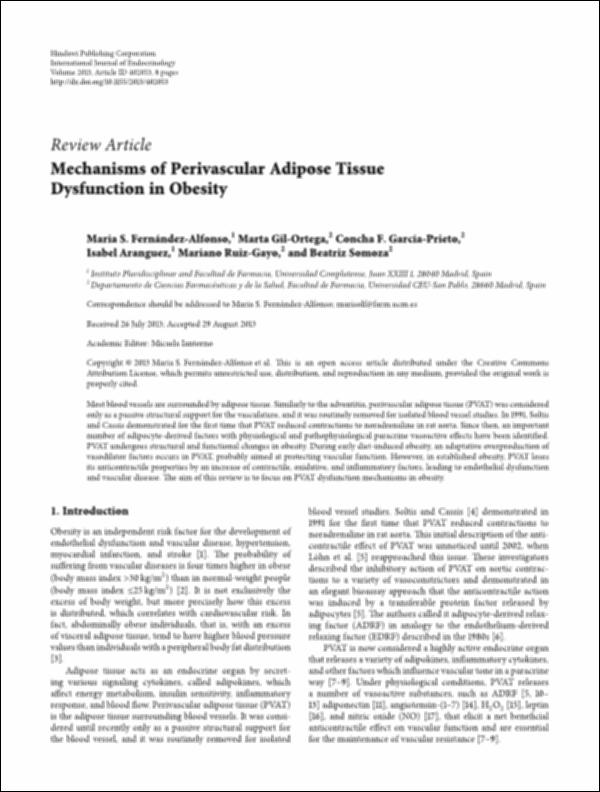Please use this identifier to cite or link to this item:
http://hdl.handle.net/10637/14607Mechanisms of Perivascular Adipose Tissue Dysfunction in Obesity
| Title: | Mechanisms of Perivascular Adipose Tissue Dysfunction in Obesity |
| Authors : | Gil Ortega, Marta García Prieto, Concepción F. Ruíz Gayo, Mariano Somoza Hernández, Beatriz |
| Keywords: | Blood vessels; Vasculature; Noradrenaline |
| Publisher: | Hindawi |
| Citation: | Fernández-Alfonso MS, Gil-Ortega M, García-Prieto CF, Aranguez I, Ruiz-Gayo M, Somoza B. Mechanisms of perivascular adipose tissue dysfunction in obesity. Int J Endocrinol. 2013;2013:402053. doi: 10.1155/2013/402053 |
| Abstract: | Most blood vessels are surrounded by adipose tissue. Similarly to the adventitia, perivascular adipose tissue (PVAT) was considered only as a passive structural support for the vasculature, and it was routinely removed for isolated blood vessel studies. In 1991, Soltis and Cassis demonstrated for the first time that PVAT reduced contractions to noradrenaline in rat aorta. Since then, an important number of adipocyte-derived factors with physiological and pathophysiological paracrine vasoactive effects have been identified. PVAT undergoes structural and functional changes in obesity. During early diet-induced obesity, an adaptative overproduction of vasodilator factors occurs in PVAT, probably aimed at protecting vascular function. However, in established obesity, PVAT loses its anticontractile properties by an increase of contractile, oxidative, and inflammatory factors, leading to endothelial dysfunction and vascular disease.The aim of this review is to focus on PVAT dysfunction mechanisms in obesity |
| Description: | En colaboración con: Maria S. Fernández-Alfonso e Isabel Aranguez |
| URI: | http://hdl.handle.net/10637/14607 |
| Rights : | http://creativecommons.org/licenses/by-nc-nd/4.0/deed.es OpenAccess |
| ISSN: | 1687-8345 |
| Issue Date: | 7-Nov-2013 |
| Center : | Universidad San Pablo-CEU |
| Appears in Collections: | Facultad de Farmacia |
Items in DSpace are protected by copyright, with all rights reserved, unless otherwise indicated.


